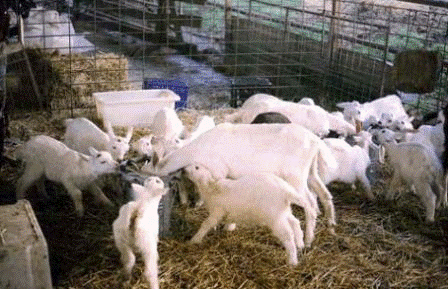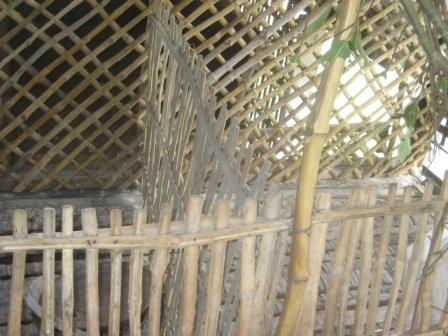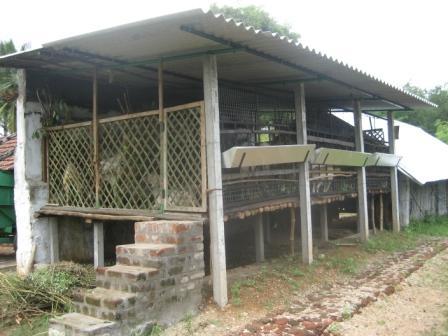Housing Management
Housing Management
Feeding and watering space requirement
|
Type of animal |
Space per animal (cm) |
Width of manger/ |
Depth of manger/ |
Height of inner wall of manger/ |
|
Sheep and goat |
40 - 50 |
50 |
30 |
35 |
|
Kid/lamb |
30 - 35 |
50 |
20 |
25 |
Recommended space requirements for Indian conditions
|
Age groups |
Covered space(sq.m) |
Opened space( sq.m) |
|
Up to 3 months |
0.2-0.25 |
0.4-0.5 |
|
3 months to 6 months |
0.5-0.75 |
1.0-1.5 |
|
6 months to 12 months |
0.75-1.0 |
1.5-2.0 |
|
Adult animal |
1.5 |
3.0 |
|
Male, Pregnant or lactating ewe/doe |
1.5-2.0 |
3.0- 4.0 |
Different systems of Sheep and Goat rearing
Extensive rearing of Sheep
- Grazing the sheep and goat in the entire pasture and leaving them there for the whole season is the extensive system of rearing.
- In this method feed cost is very much reduced.
- It is not conducive to making the best use of the whole grasses. So we can preferably practice the rotational grazing method.
- Rotational grazing should be practiced under which the pasture land should be divided by temporary fences into several sections.
- The animals are then moved from one section to another section. By the time the entire pasture is grazed, the first section will have sufficient grass cover to provide second grazing.
- Parasitic infestations can be controlled to a great extent.
- Further, it helps to provide quality fodder (immature) for most part of the year.
- Under this system, it is advisable to graze the lambs first on a section and then bring in ewes to finish up the feed left by the lambs.
Semi-intensive
- Semi-intensive system of goat production is an intermediate compromise between extensive and intensive system followed in some flocks having limited grazing.
- It involves extensive management but usually with controlled grazing of fenced pasture.
- It consists of provision of stall feeding, shelter at night under shed and 3 to 5 hour daily grazing and browsing on pasture and range.
- In this method the feed cost somewhat increased.
This system has the advantage of
- Meeting the nutrient requirement both from grazing and stall feeding.
- Managing medium to large flock of 50 to 350 heads and above.
- Utilizing cultivated forage during lean period.
- Harvesting good crop of kids both for meat and milk.
- Making a profitable gain due to less labour input.
Intensive system-zero grazing-system
- It is a system in which goats are continuously kept under housing in confinement with limited access to land or otherwise so called zero grazing system of goat production in which they are stall fed.
- It implies a system where goats are not left to fend for themselves with only minimum care.
- Intensive operation of medium sized herd of 50 to 250 heads or more oriented towards commercial milk production goes well with this system particularly of dairy goats.
- It merits exploitation of the system of feeding agro-industrial by products as on pangola grass (Digitaria Decumbens) with carrying capacity of 37 to 45 goats per hectare.
- This system of management requires more labour and high cash input.
- However, this has the advantage of close supervision and control over the animals.
- In this method the dung is collected in one place and used as a good fertilizer.
- Less space is sufficient for more number of animals.
Housing for goats
Deep litter system


- A small shed with good cross ventilation is enough to keep a small herd.
- Litter height should be atleat 6cms.
- Litter material maybe of sawdust, paddy husk and groundnut shell.
- The litter material has to be turned periodically to remove the foul odour in the pen.
- Litter material should be replaced once in every 2 weeks.
- Each goat requires about 15 sq.ft area.
- care should be taken to reduce the external parasitic infestation.
- An adult goat produces about a tonne of manure in a year.
Raised platform system

- wooden plank or wire mesh is placed about 3-4 ft from the ground level
- External parasitic infestation is usually less in this method
Source: Expert System for Sheep & Goat, ICAR-TANUVAS-TNAU
ਆਖਰੀ ਵਾਰ ਸੰਸ਼ੋਧਿਤ : 3/31/2020
© C–DAC.All content appearing on the vikaspedia portal is through collaborative effort of vikaspedia and its partners.We encourage you to use and share the content in a respectful and fair manner. Please leave all source links intact and adhere to applicable copyright and intellectual property guidelines and laws.
ਸੰਬੰਧਤ ਸਮਾਨ
Housing management
Types of housing adopted in commercial production ...
